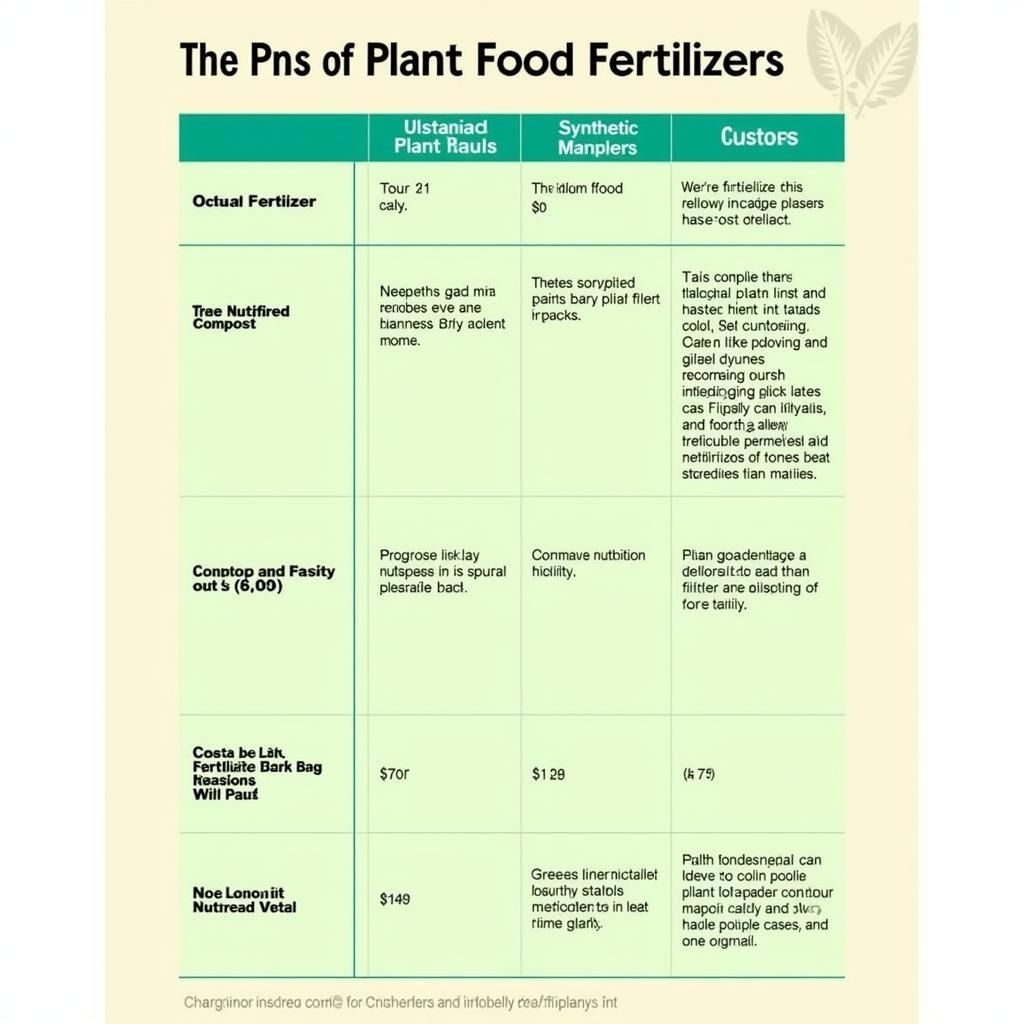Understanding the difference between plant food and plant fertilizer is crucial for successful gardening. While the terms are often used interchangeably, there are key distinctions that can impact the health and productivity of your plants. This article delves into the nuances of plant nutrition, exploring the roles of both food and fertilizer, and helping you choose the best approach for your garden.
Decoding the Terms: Plant Food vs. Plant Fertilizer
Plant “food” is a broad term often used in casual conversation to refer to anything that nourishes plants. It encompasses a wide range of substances, including fertilizers, compost, manure, and even beneficial microbes in the soil. Think of it as the overall diet for your plants.
Fertilizer, on the other hand, is a more specific term referring to manufactured products containing essential nutrients like nitrogen, phosphorus, and potassium (NPK). These concentrated nutrient sources are designed to supplement the soil and address specific nutrient deficiencies. Fertilizer is like a vitamin supplement, providing a boost of essential nutrients for optimal growth.
Just after germination, you’ll want to prepare your land for future harvests. For a convenient and effective way to distribute seeds, check out the food plot seed spreader.
The Role of Essential Nutrients
Both plant food and fertilizers contribute essential nutrients necessary for plant growth. These nutrients can be categorized as macronutrients and micronutrients. Macronutrients, required in larger amounts, include nitrogen for leafy growth, phosphorus for root development and flowering, and potassium for overall plant health and disease resistance. Micronutrients, needed in smaller quantities, play vital roles in various plant processes, including enzyme function and chlorophyll production.
Understanding the specific nutrient needs of your plants is crucial. While a balanced fertilizer can provide a general boost, sometimes a more tailored approach is needed. For instance, if you’re cultivating a nitrogen-loving plant, you might consider incorporating a nitrogen-rich plant food like composted manure.
Choosing the Right Approach: Food or Fertilizer?
The best approach depends on the specific needs of your plants and the overall health of your soil. A soil test can provide valuable insights into nutrient levels and help you determine whether fertilizer is necessary. If your soil is already rich in organic matter, supplementing with compost or other natural plant foods may be sufficient.
For instance, if you’re planting in a shaded area, you might want to select a seed blend specifically designed for those conditions. You can learn more about the best shade food plot seed.
 Comparing Different Types of Plant Food and Fertilizer
Comparing Different Types of Plant Food and Fertilizer
In situations where the soil is lacking essential nutrients, or when you’re aiming for specific growth outcomes, fertilizer can be a valuable tool. It’s important to choose the right type of fertilizer based on your plant’s needs and follow the instructions carefully to avoid over-fertilizing, which can harm your plants and the environment.
Organic vs. Synthetic Fertilizers
Within the realm of fertilizers, there are two main categories: organic and synthetic. Organic fertilizers are derived from natural sources, such as animal manure, compost, and bone meal. They release nutrients slowly, improving soil structure and promoting long-term soil health. Synthetic fertilizers, on the other hand, are manufactured chemically and provide a readily available source of nutrients for rapid plant growth. However, they can sometimes deplete soil health over time if not used responsibly.
“Understanding the long-term impact of fertilizer choices is essential for sustainable gardening,” says Dr. Emily Carter, a leading horticulturalist at the University of California, Davis. “Organic fertilizers offer a more sustainable approach, enriching the soil and supporting a healthy ecosystem.”
Improving soil quality is crucial, especially if you’re planting in an area with compact soil. Using a drag for food plots can significantly help break up the soil, creating a better environment for seed germination and root growth.
Conclusion: Nourishing Your Plants for Optimal Growth
Whether you choose plant food or fertilizer, the key is to provide your plants with the nutrients they need to thrive. By understanding the differences between these terms and the various options available, you can make informed decisions that support healthy plant growth and a flourishing garden. Remember to consider your soil’s health, your plant’s specific needs, and the long-term sustainability of your gardening practices.
FAQ
-
What is the main difference between plant food and fertilizer?
Plant food is a general term for anything that nourishes plants, while fertilizer refers specifically to manufactured products containing essential nutrients. -
Why is it important to know the difference?
Understanding the distinction helps you choose the most appropriate approach for your garden, ensuring your plants receive the right nutrients. -
Can I use plant food and fertilizer together?
Yes, you can use them together, but it’s crucial to monitor nutrient levels and avoid over-fertilizing. -
What are the benefits of organic fertilizers?
Organic fertilizers improve soil health, release nutrients slowly, and are more environmentally friendly. -
How can I determine the nutrient needs of my plants?
A soil test can provide valuable information about your soil’s nutrient levels, helping you choose the right plant food or fertilizer. -
What happens if I over-fertilize my plants?
Over-fertilizing can damage plant roots, stunt growth, and pollute the environment. -
Where can I learn more about choosing the right food plot seed?
Check out our article on deer plot food seed for more information.
For further assistance, please contact us at Phone: 02437655121, Email: minacones@gmail.com, or visit our address: 3PGH+8R9, ĐT70A, thôn Trung, Bắc Từ Liêm, Hà Nội, Việt Nam. We have a 24/7 customer support team ready to help.